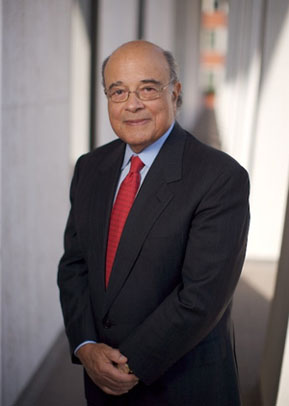Experts Outline Risk Studies for NEIDL
Panel seeks to assess “worst-case scenario”

A Blue Ribbon Panel charged with advising the National Institutes of Health on the risk assessments for the National Emerging Infectious Diseases Laboratories (NEIDL) now being built on the Boston University Medical Campus has concluded that additional studies are needed in order to address court directives and the concerns of the community.
Panel chair Adel Mahmoud, speaking Friday morning at a meeting at NIH headquarters in Bethesda, Md., told the Advisory Committee to the Director of the NIH that future risk assessments should employ methods that are accepted by the scientific community, are transparent, and are as realistic as possible.
Mahmoud also said the studies should consider both accidental and malevolent releases of a pathogenic agent.
The Blue Ribbon Panel was created after a committee of scientists convened by the National Academy of Sciences (NAS) claimed that an earlier risk assessment conducted by the NIH did not adequately identify worst-case scenarios and failed to provide sufficient information to compare the risks associated with alternative locations. The panel consists of 16 experts in infectious diseases, public health and epidemiology, risk assessment, environmental justice, risk communications, biodefense, biosafety, and infectious disease modeling.
Mahmoud, who is a professor of molecular biology at Princeton, said the task of his panel was twofold: to look at the science required to determine the risks of siting the lab in Boston, and to make sure that the concerns of the surrounding community are addressed. He said one of the more difficult charges to his group was defining worst-case scenario.
“Worst-case scenarios are a challenging and subjective concept,” he said. “No matter what scenario one devises, it is always possible for someone to imagine something worse.”
Mahmoud said his panel worked with scientists from the NAS National Research Council to come up with a common definition. They decided that worst-case scenarios should be “highly unlikely but still credible high-consequence events, and should be reality-based and scientifically accurate,” he said. Such events could result from mechanical failure, transportation accidents, security failure, exposure from vector-borne agents, human error, or malevolent actions.
Mahmoud presented the Advisory Committee, which voted to endorse his recommendations, with a list of biological agents that should be included in future studies. The list includes the reconstituted 1918 influenza virus, SARS, Rift Valley Fever virus, the Marburg virus, and the ebola virus. Agents listed, Mahmoud said, will not necessarily be studied at the NEIDL.
NIH Advisory Committee member Amy Patterson, director of the Office of Biotechnology Activities of the NIH Office of Science Policy, suggested that the risk assessments, which will be conducted by an independent consultant hired by the NIH, will determine the biosafety level that the new laboratory will operate under. It is currently slated for operation at biosafety level 4.
Ellen Berlin, director of corporate communications for the Boston University Medical Campus, said she was pleased that the Advisory Committee to the Director of NIH had endorsed the panel’s approach. “The panel’s deliberative approach to this process is necessary and appropriate,” she said.
Art Jahnke can be reached at jahnke@bu.edu.

Comments & Discussion
Boston University moderates comments to facilitate an informed, substantive, civil conversation. Abusive, profane, self-promotional, misleading, incoherent or off-topic comments will be rejected. Moderators are staffed during regular business hours (EST) and can only accept comments written in English. Statistics or facts must include a citation or a link to the citation.